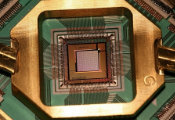Quantinuum Researchers Are Developing a New Way to Think About Computing With Light
January 19, 2024 -- Quantum computing is a young, dynamic field – so young that the community is still exploring multiple different “architectures” for quantum computers. The computer “architecture” can roughly be described as what the computer is made out of – in other words, is it made out of superconductors or semiconductors? Are the qubits made from ions, superconducting “squids”, atoms, or even particles of light? We call these different physical realizations the “architecture” or “modality”.
Exploring the pros and cons of all the different modalities is an important part of current quantum computing research. Because Quantinuum is committed to the community, and even though our hardware is trapped-ion based, we often work in partnership with researchers exploring alternate options. This work allows us to both develop quantum technologies outside our own architecture while better developing our hardware-agnostic software.
Recently, Quantinuum's Oxford team has made big strides in our understanding of “photonic”, or light-based, quantum computing. First, they developed a string-diagram formalism for describing linear and nonlinear optics. Then, they applied their formalism to solve outstanding problems in the field.
The graphical approach made solving some problems in particular much easier than they would have been using more standard linear algebra techniques, in part because the circuits they are describing have a two-dimensional structure, just like the string diagrams themselves. By creating a diagrammatic representation of the circuits themselves, the researchers are more easily able to compute things such as the change in the circuit when a parameter is adjusted.
In their most recent paper, the team figured out how to take the derivative of (or “differentiate) linear optical circuits, which means they can now figure out how the circuit will change when certain parameters are adjusted. Differentiation is central to a whole class of algorithms (including optimization algorithms and any algorithm making use of “gradient descent”, which is a key component of many machine learning and AI techniques), making the teams’ results incredibly useful. This work will form the basis for an upcoming software platform for photonic quantum computing.
In addition, this graphical approach to describing optical circuits is particularly advantageous for reasoning about multiple particles and composite quantum systems, like one must to understand fault-tolerance in quantum computing. While graphical languages are fairly new in the photonics sphere, they already seem to offer an insightful new perspective. Their current results open the door to “variational” approaches, which are used to solve things like combinatorial graph problems or problems in quantum chemistry.




































